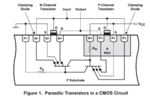surreyian
Member level 3
Hello,
Read a lot about guard ring prevent latch up. How exactly does guard ring prevent latch up?
There are a lot of discussion here that point out that the guard ring breaks up the SCR cause by the parasitics NPN and PNP, but I dont understand how a guard ring do that. So I dont understand how guard ring prevent latch up. Can someone explain this part in simple terms?
I attached 2 diagrams here. One is a layout without guardring and one is with guard ring. Both shows the parasitics NPN and PNP exist. I dont understand how with guard ring can prevent latch up.


Read a lot about guard ring prevent latch up. How exactly does guard ring prevent latch up?
There are a lot of discussion here that point out that the guard ring breaks up the SCR cause by the parasitics NPN and PNP, but I dont understand how a guard ring do that. So I dont understand how guard ring prevent latch up. Can someone explain this part in simple terms?
I attached 2 diagrams here. One is a layout without guardring and one is with guard ring. Both shows the parasitics NPN and PNP exist. I dont understand how with guard ring can prevent latch up.

